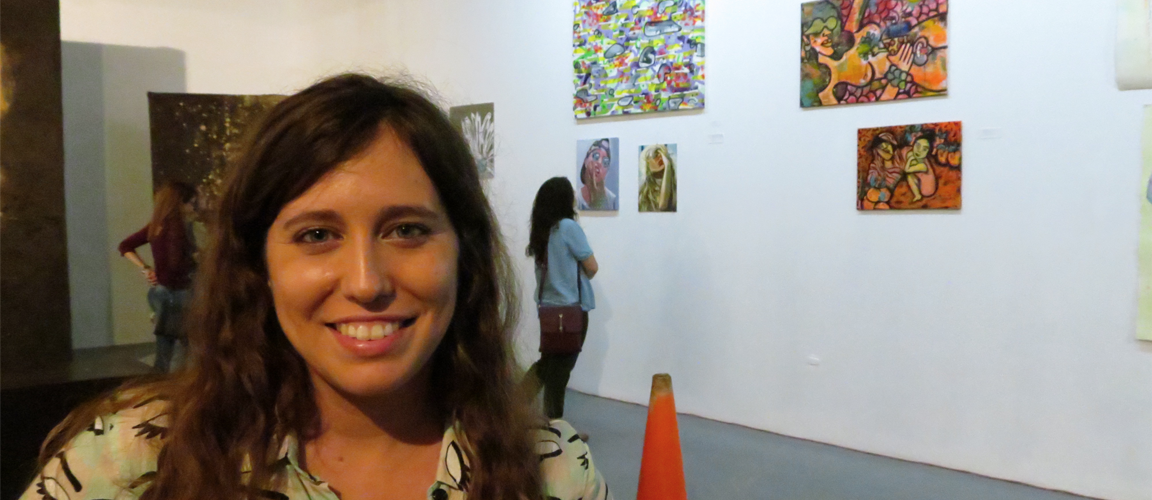
In Pale Colors: an interview with Sofía Maldonado briefly recollects the last three years of the puertorican artist’s career. From her last solo exhibition in New York to her current artistic proposal, we caught up with Maldonado in the 5th gallery night of Open Studio, a space curated by the artist that promotes the production of young undergraduate art students.
Professional and Artistic Aspects
SmartArt: How has coming back to Puerto Rico and producing projects with a social/demographic/educational experience, acted as pivotal aspects in your career and the modification of your artistic proposal?
Sofía Maldonado: In 2012 I did a solo exhibition in New York titled “Into Grey”, a piece that worked abstraction although there were still figurative and collage elements. That same year I come back to Puerto Rico to work on Bienal del Muralismo produced by MAPR and Foundation for Puerto Rico. During this time I was beginning to contemplate on the differences between the concepts of urban, community, and public art as well as searching for a change inside my artistic proposal. And so, alongside Marisol Plar, I began to provide the course/seminar “Urban, Public, and Community Art” in the Escuela de Artes Plásticas where we presented these three entities apart from one another. I think this was a very personal process I had to undergo because of the necessary distinction I needed to make. The course was very important because I found a backup to ground the proposals I was beginning to explore.
SA: What was the beginning/purpose of the project Kalaña?
SM: Kalaña was an independent artist project that began this whole way of working with the airless sprayer and the idea of how art, color, and abstraction can intervene and thus, transform a space for the community. I come about the project through a mural I did in Windwood which integrated many techniques I was working on in the studio, specifically scrapping and dripping; it was the first mural where I questioned how an artist can work on a contemporary proposal without it being classified as a urban art. While searching for the meaning of my proposal I decided to focus on the reality of abandoned buildings in the economic crisis by using color as a significant element. Paint doesn’t need to be graphic or understood by everyone, yet the color is the most crucial element. The color is was says “this space is unused/abandoned and this, it has been painted”.
SA: Where does your fascination for abstract muralist come from?
SM: I like stepping out of the canvas, or the square. It has to be an experience where people can walk into the piece. These are the ideas where abstraction and color come from, as a way of pointing these things out. For example, the mural in Dorado was a way of letting the community know that a public art project doesn’t have to be completely painted, the color can travel through the space and it doesn’t have to impose itself.
Dorado
SA: How was your experience in the arte_FITS artist residency program?
SM: While working as a professor I went with the Suarez twins to an exhibition produced by the Foundation, there I met the whole team applied to their artist residency program. I created a habit during the whole week of spring break, 2015 of waking up, going swimming, taking photographs of the roads and the flowers, then coming back to the studio and interpretation the images I had taken. I was submerged in the whole project.
A year later we did the exhibition with the nineteen acuarelas I had produced and the images of Kalaña. The collaboration with the whole team was very interesting because I got to know their curator’s point of view of my artistic production and constantly received ideas from the museologist, such as printing at large scale the images of Kalaña.
SA: What led you to produce part of the …A Color projects in Dorado?
SM: I really didn’t even notice I was using the concept of …A Color. The title of the event was very difficult because there were many things happening: live painting, conferences, workshops, musical interventions, etc. The idea of keeping the ‘A Color’ name was to follow a line a tie Cromática, Kalaña, and the nineteen acuarelas.

